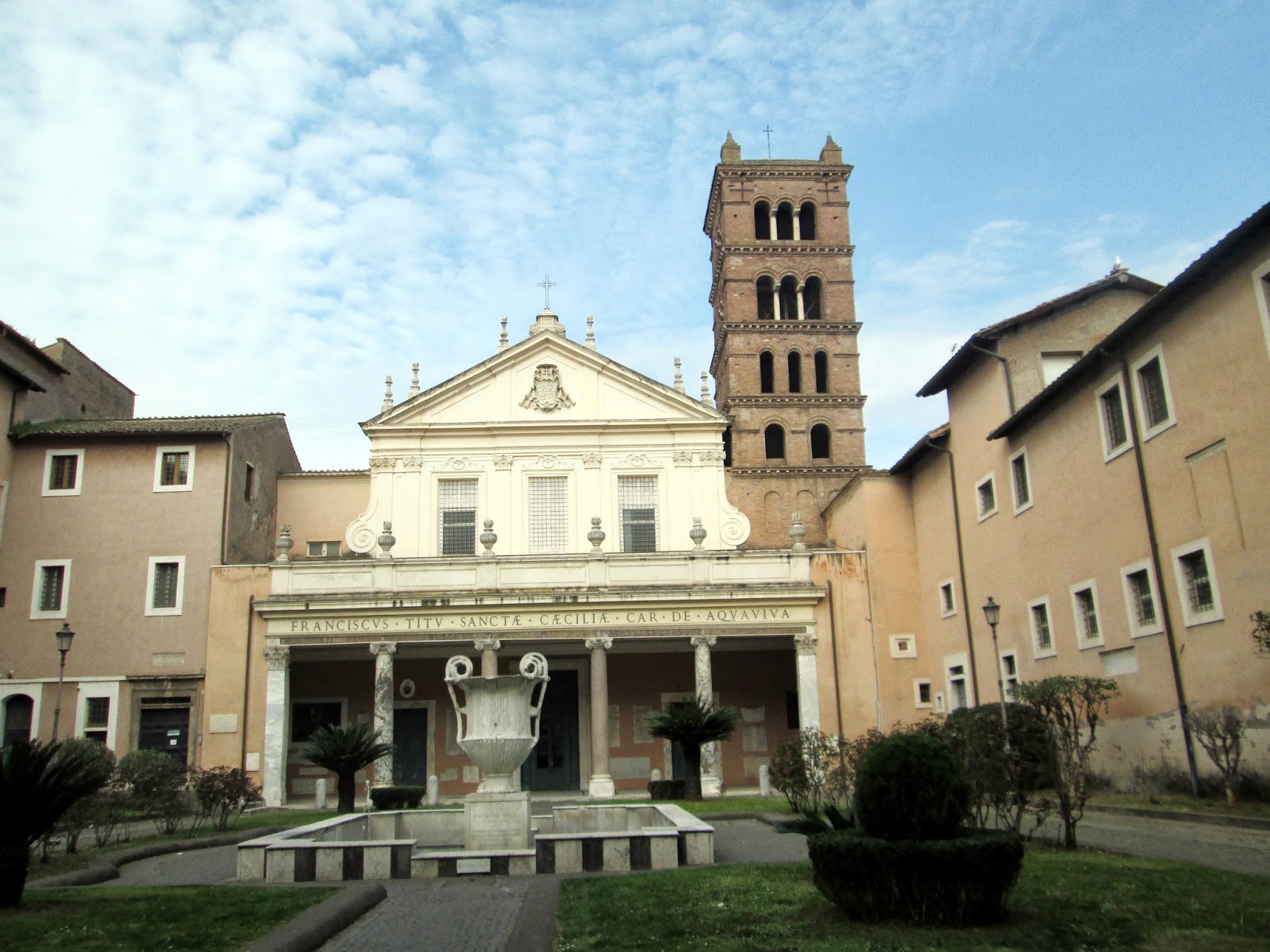1. Basilica di Santa Cecilia in Trastevere - V century
The church was devoted to the Roman martyr Cecilia, 202 AD. Legends said that the house was a " Titulus "; means it is her family's house used as a gathering place for early Christians because during her time practicing a religion in a public place is an insult for those who are non-believers. She suffered torture under the reign of Marcus Aurelius Severus Alexander. Some of her relics are found at this old Titulus that's why Pope Urban I founded the church and was recognized as the first church built on this site propbably in 3rd century.
At the beginning of 9th century, Pope Paschal I rebuilt the church and moved here the relics of Santa ecilia from the catacombs of St. Calixtus.
The church has a modern façade built in 1725 by Ferdinando Fuga, its decorations includes the coat of arms and the dedication to the titular cardinal who paid for the façade, Francesco Cardinal Acquaviva d'Aragona.
( The façade as seen on the photo above )
Among the artifacts remaining from the 13th century edifice are a mural painting by Pietro Cavallini.
 |
| The ceiling was decorated by Antonio del Massaro (1470) |
The most remarkable graphic altar sculpture of Santa Cecilia by the late-Renaissance sculptor Stefano Maderno (1600). The pavement in front of the statue encloses a marble slab with Maderno's sworn statement that he has recorded the body as he saw it when the tomb was opened in 1599.
The statue depicts the three axe strokes described in the account of her martyrdom and to underscore the incorruptibility of her cadaver which still had congealed blood after centuries.
This statue could be convinced as proto-Baroque.
The Gothic ciborium (it. ciborio) is surrounded by four marble columns, decorated with statuettes of angels, saints, prophets, and evangelists. The apse has remains of 9th century mosaics depicting the Redeemer with
Saints Paul, Cecilia, Paschal I, Peter, Valerian, and Agatha.
Some visitors may not appreciate what these blocks of stones are, but
for those who are studying History of Arts these are essential.These are the old murals designed during the Byzantine empire.
End of 1.
2.Basilica di Santa Maria in Trastevere
Known for its nave lines with a mismatched collection of columns taken from the ancient Baths of Caracalla. The apse is covered in gold mosaics from the 13th century. According to legend, the church was founded in 222 and written records mention a church on this place in 337 but what is visible today was built in the 12th century by order of Pope Innocence III.
The facade is decorated with mosaics representing the Virgin Mary and 10
figures. Traditionally, women held processions from this church going
to Santa Maria Maggiore which they concluded that the 10 figures are depicting the procession which I believe is held during March 9. Most probably these mosaics are the work also of Petro Cavallini dated 1290 while the mosaics of the upper apses in byzantine style are dated from 1140.
The Romanesque campanile is from the 12th century. Near the top, a niche protects a mosaic of the Madonna and Child.
The facade is even more impressive at night when it is illuminated!
 |
| Domenico Zampieri's octagonal ceiling painting of the Assumption of the Virgin (1617). |
 |
| Mosaics by Petro Cavallini (1291) |
 |
| " Targa antica " - names of owners, descriptions, informations.. ecc are inscribed on pieces of marble or metal. |
 |
| More byzantine murals. |
 |
| Nave from the aisles came from the ruins of the Baths of Caracalla. |
The octagonal fountain already appears in a map of 1472, and was restored by Carlo Fontana.
End of 2.
3. The Pantheon
The Pantheon is commissioned by Marcus Agrippa during the reign of Augustus as a temple to all the Gods of ancient Rome, and rebuilt by the emperor Hadrian about 126AD.
The building is circular with a portico of large granite Corinthian columns under a pediment. A rectangular vestibule links the porch to the rotunda, which is under a concrete dome, with a central oculus or opening to the sky. Almost 2000 years after it was built. the Pantheon's dome is still the largest unreinforced concrete dome.
I haven't done further researches about Pantheon, all I know is it undergone several restorations and modifications, like the original bronze cupola has been removed to use the bronze for the construction of Castel Sant'Angelo. And I wasn't able to take pictures inside due to massive crowds, anyway inside were the tombs of saints, popes, kings, and so on..

































